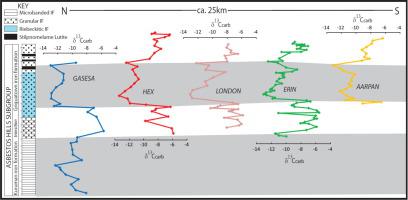Gondwana Research ( IF 6.1 ) Pub Date : 2022-05-18 , DOI: 10.1016/j.gr.2022.05.007 H. Tsikos , M. Siahi , S. Rafuza , X.R. Mhlanga , P.B.H. Oonk , V. Papadopoulos , A.C. Boyce , P.R.D. Mason , C. Harris , D.R. Gröcke , T.W. Lyons

|
The origin of Precambrian iron-formations (IF) remains contentious, particularly with respect to the mineralogy of primary precipitates and the exact processes and conditions leading to their formation. Despite the uncertainties, prevailing hypotheses range from biological precipitation of ferrihydrite to abiotic water-column formation of greenalite. By contrast, iron carbonate minerals (siderite, ankerite) in IF have traditionally been attributed to diagenetic origins based on textural and isotopic relationships. Recent studies on IF from the Neoarchaean-Paleoproterozoic Transvaal Supergroup of South Africa have revealed evidence for apparently primary, low-δ13C, Fe/Mn-bearing Mg calcite as precursor to iron carbonate formation and as a potentially underestimated pathway of isotopically light carbon burial during IF deposition. Here, we present whole-rock δ13C data and carbonate-specific geochemical analyses for samples from five drill cores that capture the entire stratigraphic extent of the Kuruman and Griquatown IF of the Transvaal Supergroup. Our results demonstrate remarkable consistency in stratigraphic profiles among the locations for the trends and magnitudes of bulk δ13C values that are independent of paragenetic association, modal mineralogy, and chemical composition of the bulk carbonate fraction of each sample. We interpret these records as resulting from water-column abiotic carbonate formation that was accompanied by kinetic isotopic effects associated with fluctuating conditions (pH, alkalinity) controlling carbonate supersaturation in ambient seawater. Although our interpretation provides strong support for abiotic, anoxic models for IF genesis prior to the Great Oxidation Event (GOE), it does not entirely preclude additional biological mechanisms of primary ferric oxyhydroxide formation and its possible role in an early biological pump.
中文翻译:

前寒武纪铁地层碳同位素地层学及早期生物泵的可能意义
前寒武纪铁地层 (IF) 的起源仍然存在争议,特别是在初级沉淀物的矿物学以及导致它们形成的确切过程和条件方面。尽管存在不确定性,但普遍的假设范围从水铁矿的生物沉淀到绿藻的非生物水柱形成。相比之下,IF 中的碳酸铁矿物(菱铁矿、铁辉石)传统上基于结构和同位素关系归因于成岩成因。最近对来自南非新太古代-古元古代德兰士瓦超群的 IF 的研究揭示了明显初级、低 δ 13的证据C,含铁/锰的镁方解石作为碳酸铁形成的前体,以及在 IF 沉积过程中可能被低估的同位素轻碳埋藏途径。在这里,我们展示了来自五个钻芯的样品的全岩 δ 13 C 数据和特定碳酸盐的地球化学分析,这些样品捕获了德兰士瓦超群的 Kuruman 和 Griquatown IF 的整个地层范围。我们的结果表明,地层剖面在体积 δ 13的趋势和大小的位置之间具有显着的一致性C 值独立于共生关联、模式矿物学和每个样品的大块碳酸盐部分的化学成分。我们将这些记录解释为水柱非生物碳酸盐形成的结果,伴随着与控制环境海水中碳酸盐过饱和的波动条件(pH、碱度)相关的动力学同位素效应。尽管我们的解释为大氧化事件 (GOE) 之前的 IF 发生的非生物、缺氧模型提供了强有力的支持,但它并不完全排除初级羟基氧化铁形成的其他生物学机制及其在早期生物泵中的可能作用。


























 京公网安备 11010802027423号
京公网安备 11010802027423号